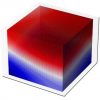Description
The course is divided into two sections 1) the simulation of aerobic and anaerobic biological processes for wastewater treatment and 2) the automatic control of urban and industrial wastewater treatment plants.
Units
- Mathematical simulation of biochemical processes. Stoichiometry of reactions. Stoichiometry of microbial growth reactions based on thermodynamics. Kinetics of enzyme reactions and microbial growth reactions. Mass balances in continuous reactors (ideal and non-ideal). Presentation of models in table format.
- Anaerobic digestion model (ADM1). Anaerobic digestion steps taken into account by the ADM1 framework model. Growth rates, inhibition, interactions. Physicochemical and microbial processes of the model. Simplification of models (rate-limiting step, perturbation analysis).
- Introduction to Aquasim software. Application to simple models. One- or two-step bioprocesses that take place in a batch or continuous stirred reactor or reactors in series. Simulation process in aquasim and parameter estimation. Visualization of results.
- Implementation of the anaerobic digestion model on the Aquasim platform and simulation of anaerobic processes (simulation of anaerobic digestion of mill waste, urban sludge).
- Introduction to control systems for wastewater treatment plants. System architecture, control algorithms, manipulated variable calculation methodologies, feedback, feedforward. Control types (P, I, PI, PID).
- Scalar control, adaptive control, selection of fixed points. Description of the components of automatic control systems.
- Examples. Automatic control of A’ sludge removal. Sludge recirculation and excess sludge control strategies. Control of nitrogen removal in pre-denitrification systems. Control of ventilation. Automation of processes in the pilot biological reactors of the laboratory of liquid waste management and technology.
- Simulation of aerobic biological processes. Complexity of biological processes, utility of simulation. Layout of table-type mathematical equations, components and reactions. Applications of dynamic simulation of biological processes.
- Introducing and learning the STOAT simulation program. Elements and materials used by STOAT. Mathematical models used for the various processes. Instructions for calibration. Sensitivity analysis.
- Examples of planning and optimizing the operation of a liquid waste treatment plant. Simulation of activated sludge systems for carbon and nutrient removal (extended denitrification, cyclic processes, SBR).
- Anaerobic reactor monitoring techniques. Measurable variables in anaerobic reactors in the solid, liquid and gas phase and the possibility of exploiting them in regulation systems.
- Setting up anaerobic reactors. Set point control systems, anaerobic reactor optimization systems, complex step control type regulation systems, expert systems
- Phase diagrams of dynamic systems through various software (Maple excel). Interpretation of phase diagrams. Stability of open and closed loop systems.
